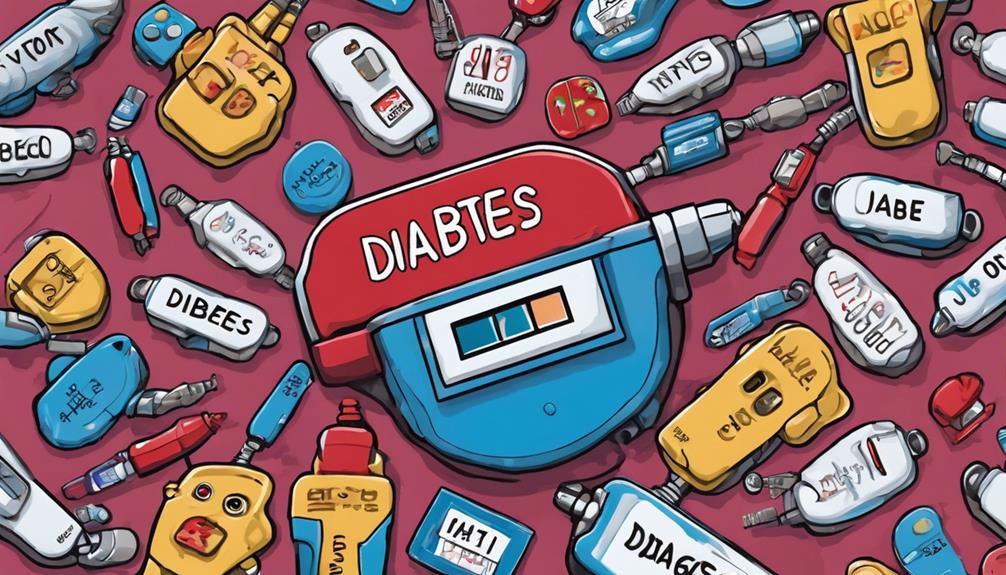We recognize that talking about foot issues may not be a high priority, but when it comes to diabetes, even small problems like ingrown toenails can have significant consequences.
The connection between diabetes and ingrown toenails goes beyond discomfort, potentially leading to more severe complications.
As we delve into the relationship between these two seemingly unrelated topics, you'll discover the critical importance of proactive care in managing this common issue for individuals with diabetes.
Key Takeaways
- Ingrown toenails pose severe risks for diabetics due to impaired circulation.
- Regular podiatric care is crucial for diabetic foot health maintenance.
- Specialized podiatrist assistance is essential for treating ingrown toenails in diabetics.
- Proactive care and early intervention help prevent complications in diabetic individuals.
How Ingrown Toenails Develop
Ingrown toenails develop when the edge of the nail grows into the skin surrounding the toe, particularly affecting the big toe. For diabetic individuals, this seemingly minor issue can lead to significant complications. Improper nail trimming techniques or wearing tight shoes can worsen the situation, causing pain, redness, and swelling. In severe cases, an infection may occur, putting diabetic individuals at higher risk due to reduced blood flow, nerve damage, and compromised immune responses.
When faced with an ingrown toenail, especially as a diabetic, it's crucial to prioritize foot care. Regular monitoring of the feet for any signs of ingrown toenails is essential. Seeking prompt treatment from a podiatrist can prevent potential complications like foot ulcers or further infections. Diabetics need to be vigilant about any foot issues due to the implications of reduced blood flow and nerve damage. Proper nail trimming techniques and wearing comfortable shoes can also aid in preventing ingrown toenails and maintaining overall foot health.
Diabetes and Ingrown Toenails

Diabetes presents unique challenges when it comes to managing toenail health, particularly the risk of complications from ingrown toenails. Diabetics face heightened risks due to impaired blood circulation, nerve damage, and elevated blood sugar levels hindering wound healing. Untreated ingrown toenails can progress to infections, foot ulcers, and severe consequences like amputation. It is crucial for individuals with diabetes to prioritize foot hygiene, regular monitoring, and professional care to prevent such complications.
| Aspect | Impact |
|---|---|
| Blood Circulation | Impaired circulation delays healing and increases infection risk. |
| Nerve Damage | Reduced sensation can lead to unnoticed injuries and delays in seeking treatment. |
| Nail Removal | Professional podiatrist assistance may be necessary to safely remove ingrown nails. |
| Wound Care | Proper care and monitoring are essential to prevent complications and foot ulcers. |
Managing blood sugar levels is vital for overall health and can significantly impact foot health. Regular visits to a podiatrist for diabetic foot exams and early intervention are key to maintaining healthy feet and preventing severe complications.
The Importance of Seeing a Podiatrist
Understanding the significance of regular podiatric visits can greatly benefit individuals with diabetes in maintaining optimal foot health and preventing potential complications. Diabetic patients are particularly vulnerable to foot issues, making proactive care essential. A podiatrist can help diabetic patients by providing specialized diabetic foot care, including addressing concerns like infected ingrown toenails promptly.
By seeking professional help, individuals can reduce their risk of infection and serious complications associated with diabetic foot problems. Podiatrists have the expertise to offer various treatment options tailored to the specific needs of diabetic patients, ensuring proper care and monitoring.
Regular podiatric visits play a crucial role in managing foot health for diabetics, as timely intervention can prevent severe consequences such as ulcers, amputations, and systemic infections. Prioritizing podiatric care is key in mitigating the risks associated with diabetic foot complications and enhancing overall well-being.
Treating Ingrown Toenails

Regular podiatric visits for diabetic individuals are crucial for effectively treating and managing ingrown toenails to prevent complications and promote optimal foot health.
Diabetic individuals often require specialized treatment plans when dealing with ingrown toenails to ensure proper healing and reduce the risk of infection. Podiatrists may recommend various interventions such as antibiotics, topical solutions, or debridement to address ingrown toenails in diabetic patients.
Preventing infection and future occurrences of ingrown toenails is paramount in diabetic foot care due to the increased risk of complications associated with diabetes. In more severe cases, permanent nail removal might be considered to address chronic or recurrent ingrown toenail issues in diabetics.
Tips for Preventing Ingrown Toenails
To prevent ingrown toenails, it's essential to trim your toenails straight across and wear properly fitting shoes. Cutting nails too short can lead to ingrown toenails, so it's important to maintain a moderate length.
Good foot hygiene, keeping feet clean and dry, also plays a crucial role in preventing ingrown nails. Regularly inspecting your feet for any signs of ingrown toenails is key to addressing them promptly.
For individuals with diabetes, the risk of complications from ingrown toenails is higher due to potential circulation issues and neuropathy. Even minor foot problems can escalate quickly, so seeking medical attention for any symptoms of ingrown toenails is vital.
If you have diabetes, proper foot care is essential to prevent complications. By following these prevention tips and being proactive about your foot health, you can reduce the risk of ingrown toenails and maintain overall foot health.
Frequently Asked Questions
Why Can't Diabetics Cut Toenails?
We shouldn't cut our own toenails because diabetics face risks like reduced sensation and slower wound healing that can lead to complications. It's safer to seek guidance from a professional podiatrist who can provide proper care.
Regular foot exams and healthcare provider visits are crucial for diabetics to maintain optimal foot health and prevent issues. Let's prioritize our well-being and leave toenail care to the experts for our safety.
Are Ingrown Toenails a Symptom of Diabetes?
Ingrown toenails aren't typically a symptom of diabetes. However, diabetics face increased risks from ingrown toenails due to poor circulation and nerve damage.
People with diabetes should prioritize foot care as they're more susceptible to infections and complications. Prompt professional care is crucial for diabetics experiencing ingrown toenails to prevent serious issues.
Managing foot health is essential for diabetics to avoid infections, ulcers, and other complications.
What Are the First Stage of Diabetic Toenails?
When we consider the first stage of diabetic toenails, it's essential to note the initial signs like redness, tenderness, and swelling near the affected area. Pain upon pressure application and potential skin covering the nail edge are common early symptoms.
Monitoring these indicators diligently is crucial to prevent severe complications such as infections and ulcers. Timely attention to the first stage can facilitate effective treatment and avert the progression to more severe foot problems.
What Does a Diabetic Toe Look Like?
When we look at a diabetic toe, we might notice signs of redness, swelling, warmth, or discoloration. These could indicate potential issues like infection, poor circulation, or tissue damage.
Due to nerve damage, diabetic toes may lack sensation, making it harder to detect injuries early. Ulcerations or sores might signal more serious foot problems needing immediate attention.
It's crucial to monitor these changes closely and seek medical advice promptly.
Conclusion
In conclusion, managing ingrown toenails as a diabetic requires proactive care and attention. By seeking help from a podiatrist and following prevention tips, we can avoid serious complications like infections and amputations.
Remember, taking care of our feet isn't just important, it's crucial for our overall health and well-being. Let's make sure to prioritize our foot health to stay on our toes and keep moving forward with confidence.









